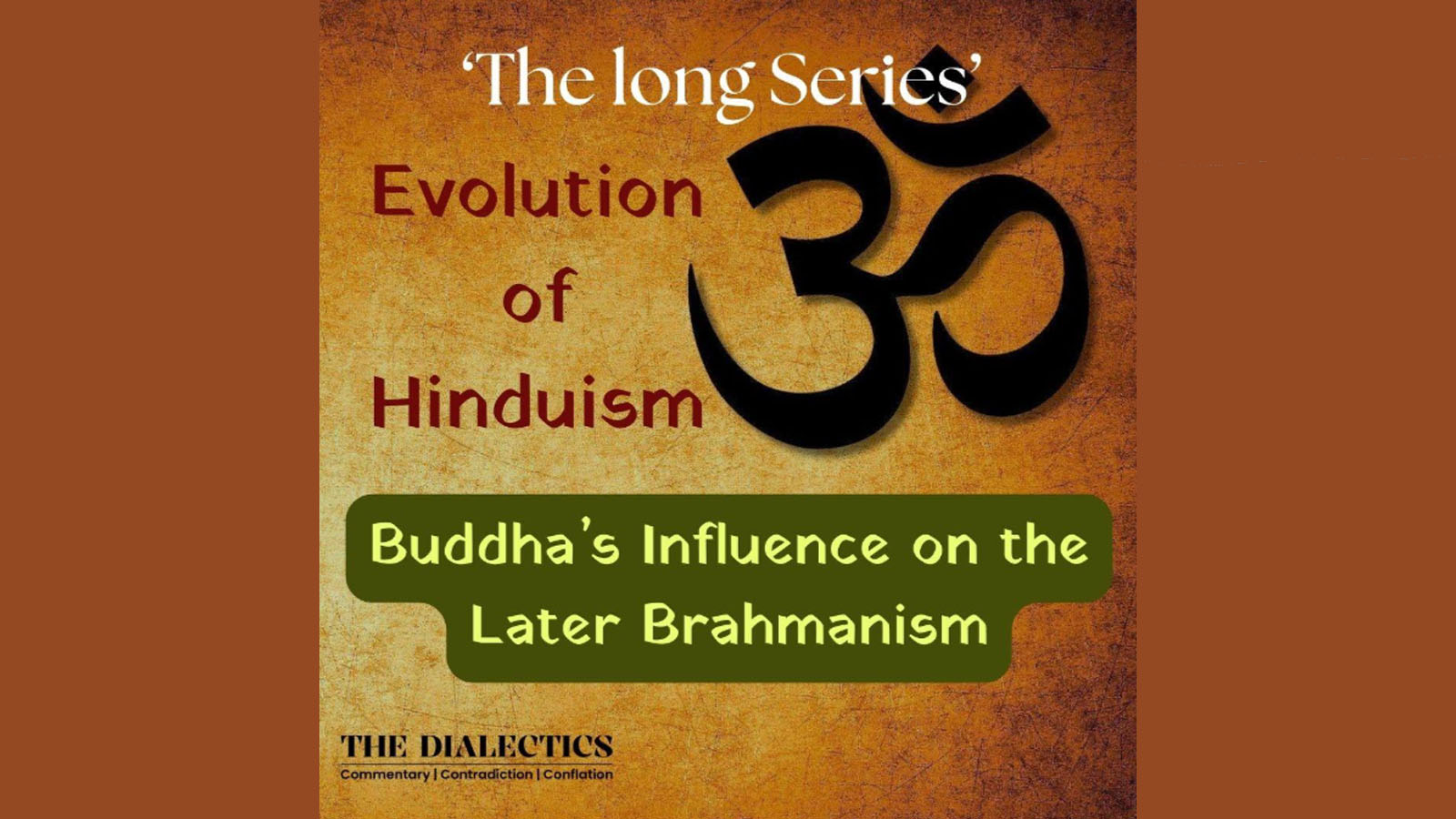‘The purpose of religion is to explain the origin of the world. The purpose of Dhamma is to reconstruct the world.’ (Ambedkar, 1987: 322) With these words Dr. B. R. Ambedkar interpreted Buddhism as a world transforming religion. During the end of the Upanishad period, the Uttarapatra (north highway) was made. Linking the fertile lands of Yamuna and the Ganga Valley, it led to the period of second urbanisation in the Indian sub-continent. Leading to major economic growth it gave birth to new religious sects and philosophical ideas. Among them, the chief religious sects were Buddhism, Vaishnavism, Saivism, and Jainism.
When we speak of Brahmanism, Monier Monier-Williams marks, “Pure philosophical Brāhmanism is identified with the Vedanta Systems, which is built upon the doctrine of Brahman.” The discussion of the article centers around the influence of Buddhist philosophies on Brahmanical Hindu religion and its philosophical tradition.
Tara Nanda Mishra observed that both Jainism and Buddhism were fostered by heterodox leaders denying the supreme authority of Vedas. Still, they inherited some of the old traditional methods of Tap, Yoga, Bhaikshacharya (begging alms), Charanatika (wanderer), Ekantvasa (living in Seclusion), Asrmavasa (staying away from the common mass in the hermitage) and live at a fixed place during rainy season. In this way they were influenced by the Rigveda.
Buddhism is a religion of reason, rejecting all that reason does not comprehend. Buddhism makes its constant appeal to Buddhi, the human intellect as a supreme judge in the religion. The influence of Buddhist philosophy on India’s culture, and civilization over many centuries cannot be overstated, having significantly shaped its development in many ways. It is important to note that Buddhist influence can be seen in both language and doctrine of the Upanishads.
Dhamma’s Influence on Upanishads
The Buddhist declared animal sacrifice as a crime, as it had resulted in slaughter of an innocent creature, emphasizing compassion and mercy towards all living beings. Contrasting sharply with the sacrificial rites practiced by the Brahmans. Brahmans were in fact compelled to modify their system. The anti-sacrificial tendency of a few Upanisadic passages seems to be inspired by Buddha’s critical attitude towards Vedic Karmakanda. Some of Upanisadic teachers agreed with the Buddha in criticising Vedic sacrificial slaughter of the animals.
Moreover, some of the Upanisadic philosophers agree with the importance of inner awakening over external ceremonies and emphasized Karman, Dhyana and Yoga. The Buddhist concept of Nirvana, the ultimate truth is similar to Upanisadic concept of ultimate reality, Brahman and Atman. Additionally, both the Philosophies highlight the importance of consciousness or vijnana. The Brihadaranyaka Upanishad mentions ‘Reality’ (bhuta) as an infinite and limitless mass of consciousness,’ which is similar to Dighanikaya’s description of consciousness as ‘invisible, infinite and shining everywhere.’
Doctrines of Ahimsa, Karma and Rebirth
The Bhagavad Gita incorporates many Buddhist principles and practices. Historian, D. D. Kosambi, who dates the text between 150-350 AD, notes that its idea of achieving perfection through multiple rebirths is ‘characteristically Buddhist.’ Moreover the moral principle of ahimsa (non violence), which is central to Jainism and Buddhism was not known to the Vedic texts but later became an important aspect of Hinduism. In Buddhist texts, ahimsa is the foremost of the ‘five precepts’ (pañca sila) and the anusasanaparva of the Mahabharata also declared ahimsa to be the ‘supreme duty’ (paramo dharmah).
The idea of karma originated in the ancient Indian tribal religions in the Gangetic region where Buddhism and Jainism flourished. The Upanishad states that after death, the various parts of a person return to the elements of nature from which they originated, including the soul (atman) which goes into space, with only one’s karma or effect of work remaining. Passages from the Brihadaranyaka Upanishad point out that, “a man turns into something good by good action and into something bad by bad action.” Mahabharata also predict rebirth as an outcast for those who misbehave. Over time the notion of Karma and rebirth influenced Brahmanism, shaping their doctrines and integrating the principles of Karma, yoga, and ahimsa into Hindu philosophy.
Decline of Buddhism
Many scholars have traced the decline of Buddhism from the seventh century AD. Lal Mani Joshi on the decline of Buddhism in India divides the factors into internal and external. The internal factors such as Moral degradation, Sectarian Disputes, Mahayana Influence, revival of Brahmanism, etc. led to its decline. As remarked by Chinese pilgrims and Indian literature, during the seventeenth and eighteenth centuries Buddhist monks and nuns experienced moral decline. Though they wore the monastic dress yet they killed animals, reared cattle and maintained wives and children. Moreover, the Mahayana approach blurred the distinction between Buddhism and Hinduism, Bodhisattva Yana seems to have initiated the institution of married monks.
The Brahmanical hostility towards Buddhism was a major external factor for the decline. Brahmanas often showed disdain for Buddhist monks, and texts. Additionally, the decline in royal patronage and royal Persecution also contributed to its decline. After Harshwardhana, Buddhism lost strong royal support. The sacking of Nalanda by Bakhtiyar Khalji and the Arab attacks on Buddhists of Sindh explains the absence of royal protection of Buddhism in India.
Incorporation of Buddha into Hinduism
Buddha’s influence impacted the Indian minds deeply. His images adorned thousands of pillars, walls and the gates of numerous monasteries across the country. His teachings had been pupularized through a vast body of Pali and Sanskrit literature. The Buddhist philosophies and doctrines were praised by countless Indians for centuries. Given the profound impact, Buddha was too significant and thus became a member in the pantheon of avataras. This signifies a shift, symbolising a blending of two distinct religious traditions.
The acceptance of Buddha as an incarnation first appeared in Matsya Purana, around the sixth century A.D. This incorporation illustrates Buddhist elements, leading to a fusion of ideas and practices between the two philosophies. However, despite its profound impact on Indian thought and culture, many challenges ultimately led to the decline of Buddhism, diminishing its presence in the land of its origin.
Author
-

Yashasvi holds her Master’s degree in History from Goa University. She is recognised for her insightful analysis and unique writing on History, culture and society.
View all posts




